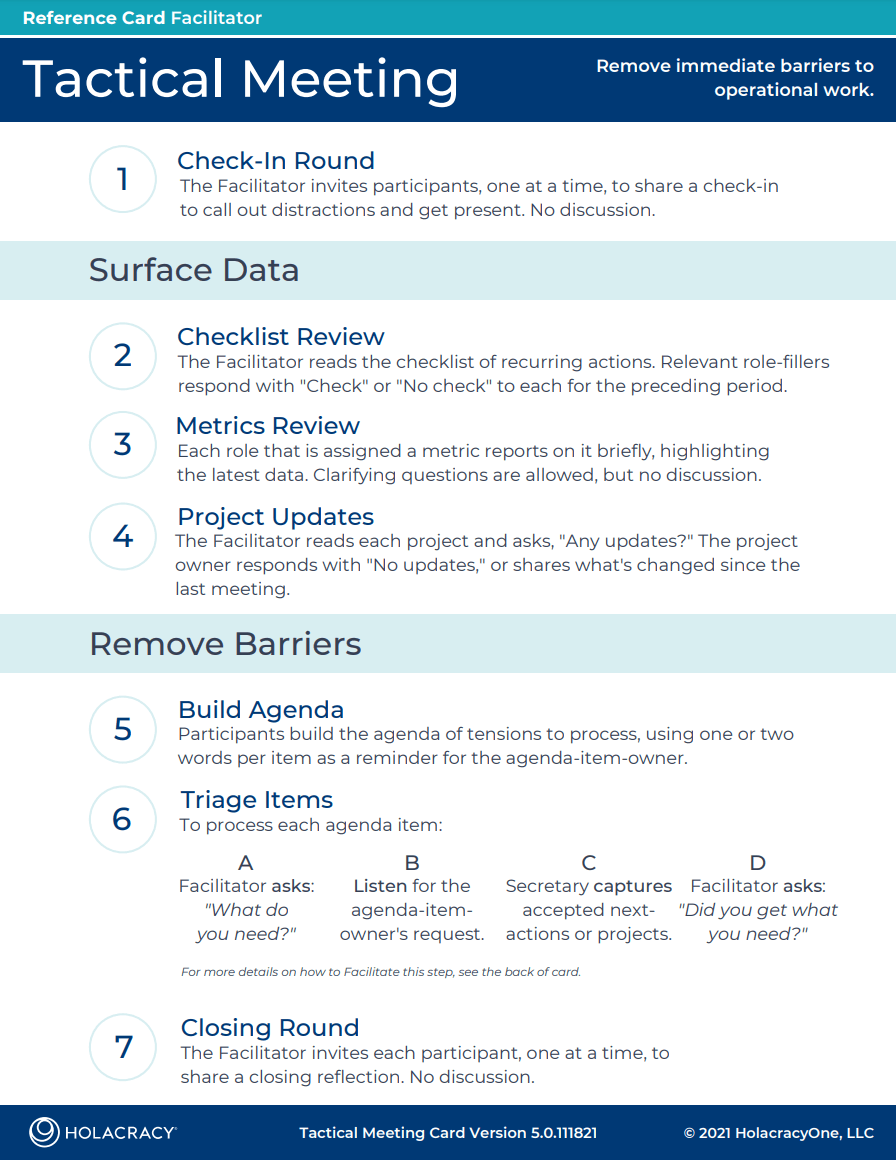Tactical meetings are focused on a team’s operational work. Their purpose is to triage issues that have come up recently and remove obstacles so that the work can move forward. Each circle in a Holacracy-powered organization has its own tactical meetings. They occur at a regular rhythm based on the needs of the circle (typically weekly) and are scheduled by the circle’s Secretary. Tactical meetings follow a structured process and are held by the circle’s Facilitator.
Sound rigid? Having a process that the whole team knows and can participate in is freeing! The structure, along with a Facilitator to hold everyone to it, provides an inclusive space. Every circle member—from the former CEO to the intern—has a chance to get what they need to do their best work.
The tactical meeting process is Holacracy’s default operational meeting and is described in Holacracy v5 Article 3.
Process
Call out distractions, get present for the meeting. One person speaks at a time, without discussion.
Preamble: The preamble is a space to surface data, not discuss it. The discipline is to resist the temptation to discuss issues in this step. Anyone wanting to discuss a topic should add it to the agenda for triage.
Checklists are used to have visibility over whether recurring actions are being done. The Facilitator reads the checklist of recurring actions. The relevant roles respond by “check” or “no check” to each item for the preceding period (e.g. the prior week).
Any circle member can request checklist items to be added to the list, as long as they are for actions that have already been accepted by the role-filler as an action their role would take. In other words, checklist items may not add new expectations on a role. If a circle member needs to add new expectations to a role, they need to propose adding an accountability via governance.
Each role assigned a metric reports on it by highlighting the latest data. It’s the Circle Lead’s authority to determine which metrics are being reported on.
The Facilitator reads each project and asks: “Any updates?” The project owner either responds “no updates” or shares what’s changed since the last meeting. Clarifying questions are allowed, but no discussion. If anyone needs to discuss the project further, they are invited to wait for the Triage Issues step to add an item to the agenda.
Triage Issues: This is the main part of the meeting, where participants triage their operational tensions.
This step starts with building an agenda of tensions to process — one or two words per item, no discussion. If needed, the circle’s Secretary captures agenda items. Any participant can also add items to the agenda later.
Once the agenda is complete, the Facilitator starts going through the list. The goal is to process all the agenda items in the time allotted, therefore the time per agenda item is limited. For example, if we have 10 items on the agenda and 30 minutes left for the meeting, then we have roughly 3 min per item (or a bit less, to account for the closing round). The purpose of the meeting is not to analyze issues in-depth, but to quickly triage them and get clear on what’s the next step to move forward.
To Process Each Agenda Item:
- The Facilitator asks: “What do you need?”
- The agenda-item-owner engages others as needed.
- The Secretary captures any Projects and Actions requested & accepted by any circle member.
- The Facilitator asks: “Did you get what you need?” If yes, we move to the next item on the agenda.
The Facilitator calls on every meeting participant. Each person can share a closing reflection about the meeting. No discussion. Done!
Download Tactical Meeting Card
Meeting cards are a useful reference tool for all participants, but especially for Facilitators.
Tactical Meeting Demo
Example of a tactical meeting conducted at Springest, in the Netherlands.


